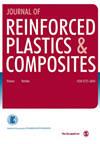带有填充图案的 3D 打印玻璃纤维增强缟玛瑙复合材料的实验和数值研究
IF 2.2
3区 材料科学
Q3 MATERIALS SCIENCE, COMPOSITES
引用次数: 0
摘要
通过使用填充图案并调整其密度,可以实现 3D 打印部件的轻量化。在这种情况下,对打印部件进行机械表征和数值模拟势在必行。本手稿对 3D 打印复合材料(缟玛瑙/玻璃纤维)进行了实验和数值研究,考虑了样品的填充模式、墙壁、屋顶和地板。采用数值均质化方法确定了填充图案的弹性力学参数。结果表明,均质工具在预测填充图案的力学参数方面非常有效。建立了填充密度与各均质化力学参数之间的相关关系,从而能够根据所使用的填充图案及其密度计算各力学参数,而无需重复进行力学均质化。关于拉伸和弯曲试样的模拟,结果表明,拉伸的弹性模量预测误差在 2.87% 到 11.84% 之间,三点弯曲的弹性模量预测误差在 4.42% 到 8.45% 之间。考虑到试样的所有组成元素,对 3D 打印复合材料进行模拟,可以检查每个元素中的应力场,并确定应力最大和最小的区域。这些发现有助于在解决工程问题的背景下预测 3D 打印复合材料的行为。本文章由计算机程序翻译,如有差异,请以英文原文为准。
Experimental and numerical investigations of 3D-printed glass fiber reinforced onyx composites with infill patterns
The lightweighting of 3D-printed components is achievable by using infill patterns and the ability to adjust their density. In this context, performing a mechanical characterization and numerical simulation of the printed parts is imperative. This manuscript conducts experimental and numerical investigations on 3D-printed composites (onyx/glass fibers) that consider the infill pattern, walls, roofs, and floors of the samples. A numerical homogenization approach was adopted to identify the elastic mechanical parameters of the infill patterns. The results demonstrated the homogenization tool’s effectiveness in predicting the mechanical parameters of the infill patterns. Relationships correlating the infill density and each homogenized mechanical parameter were established, enabling the calculation of each mechanical parameter based on the used infill pattern and its density without reiterating the mechanical homogenization. Regarding the simulation of specimens under tension and flexure, the results indicated that the prediction error of the elastic modulus ranged between 2.87% and 11.84% for tension and between 4.42% and 8.45% for 3-point bending. The simulation of 3D-printed composites, considering all constituent elements of the specimens, allowed for examining stress fields in each element and identifying areas of highest and lowest stress. These findings can contribute to predicting the behavior of 3D-printed composites in the context of addressing engineering problems.
求助全文
通过发布文献求助,成功后即可免费获取论文全文。
去求助
来源期刊

Journal of Reinforced Plastics and Composites
工程技术-材料科学:复合
CiteScore
5.40
自引率
6.50%
发文量
82
审稿时长
1.3 months
期刊介绍:
The Journal of Reinforced Plastics and Composites is a fully peer-reviewed international journal that publishes original research and review articles on a broad range of today''s reinforced plastics and composites including areas in:
Constituent materials: matrix materials, reinforcements and coatings.
Properties and performance: The results of testing, predictive models, and in-service evaluation of a wide range of materials are published, providing the reader with extensive properties data for reference.
Analysis and design: Frequency reports on these subjects inform the reader of analytical techniques, design processes and the many design options available in materials composition.
Processing and fabrication: There is increased interest among materials engineers in cost-effective processing.
Applications: Reports on new materials R&D are often related to the service requirements of specific application areas, such as automotive, marine, construction and aviation.
Reports on special topics are regularly included such as recycling, environmental effects, novel materials, computer-aided design, predictive modelling, and "smart" composite materials.
"The articles in the Journal of Reinforced Plastics and Products are must reading for engineers in industry and for researchers working on leading edge problems" Professor Emeritus Stephen W Tsai National Sun Yat-sen University, Taiwan
This journal is a member of the Committee on Publication Ethics (COPE).
 求助内容:
求助内容: 应助结果提醒方式:
应助结果提醒方式:


